Division of Animal Behavior
Marlene Zuk Award for best talk: Janice Yan
 Sexual conflict, social networks, and the fitness consequences of female multiple mating
Sexual conflict, social networks, and the fitness consequences of female multiple mating
‘I completed my PhD in Reuven Dukas’ Cognitive Ecology Lab at McMaster University. My dissertation examined how extreme sexual conflict influences the social dynamics of bed bugs. I also focused on understanding the adaptive significance of polyandry across the animal kingdom. I recently joined Christine Miller’s Lab at the University of Florida as a postdoctoral associate where I will be examining the influence of nutrition on sexual selection, honest signaling, and the social networks of weapon-bearing insects.’
Elizabeth Adkins-Regan Award for best poster: Emmy James
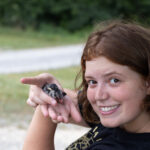 An experimental heat challenge uncovers individual variation in heat dissipation behaviors.
An experimental heat challenge uncovers individual variation in heat dissipation behaviors.
Emmy is a PhD student at the University of Tennessee Knoxville, advised by Dr. Elizabeth Derryberry. She studies avian thermoregulatory behavior to identify how populations respond to a warming world. In particular, Emmy focuses on variation in thermoregulatory behavior to determine if all individuals are good at coping with heat. She studies free-living tree swallows (Tachycineta bicolor) and their chicks, which are expanding southwards into warmer climates.
Elizabeth Adkins-Regan Award for best poster runner-up: Gwen Sailer
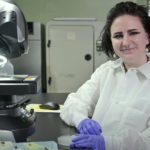 Artist meets architect: color nesting preference of M. rotundata
Artist meets architect: color nesting preference of M. rotundata
My name is Gwen Sailer, I’m in the last year of my undergraduate studies at North Dakota State University. I’m majoring in biological sciences with a minor in zoology. I have an interest in telomerase activity and phenotypic plasticity in birds. Over the summer of 2024, I was given the opportunity to participate in Pollination Nation’s REU program where I conducted research into the effects of cycloastragenol on telomerase activity in Megachile rotundata.
Division of Comparative Biomechanics
Wainwright and Koehl Award for best talk: Olivia Walthaus

The allometry of cutting efficiency in Atta cephalotes leaf-cutter ants
Leaf-cutter ants are true ecosystem engineers and the principal pest species of the Neotropics, causing 15% of the total defoliation in the region. Thought to be key to their herbivory success is there highly polymorphic workforce and associated task specialisation, thought to increase foraging efficiency. At the heart of leaf-cutter ant foraging sits cutting which is both mechanically demanding and energetically costly. The ratio between the mechanical work output and the metabolic expenditure defines the efficiency of the behaviour. Are all worker sizes equally efficient leaf cutters? To answer this question, we measured mechanical power output and metabolic power demand associated with leaf-cutting across the polymorphic work force in Atta cephalotes leaf-cutter ants. Metabolic power increased with size, while mechanical power initially increased but plateaued at larger sizes, leading to peak cutting efficiency at intermediate worker sizes.
Steven Vogel Award for best poster: Heiko Kabutz
 The control of shape during laterally confined locomotion of Araneae, Hognacarolinensis
The control of shape during laterally confined locomotion of Araneae, Hognacarolinensis
I am a PhD student at the University of Colorado Boulder. My research explores how terrain confinement, such as lateral constraints, affect the locomotion of ground running spiders in cluttered environments. Using high-speed videography, we quantified kinematic metrics across varying lateral constraint levels. Results showed that spiders maintain leg cycling frequency and sagittal plane motion but exhibit increased lateral center of mass fluctuations under higher constraints. Analysis revealed adaptive shape changes in body-appendage coordination, offering a novel framework to compare biological and robotic systems.
Division of Comparative Endocrinology
Audrey Gorbman Award for best talk: Lauren Merlino
 The endocannabinoid 2-AG mediates seasonal life-history transitions in a wild reptile
The endocannabinoid 2-AG mediates seasonal life-history transitions in a wild reptile
I am a Ph.D. candidate working with Deborah Lutterschmidt at the University of California, Irvine and am planning to pursue a career as an academic research scientist. My research interests focus on the neuroendocrine mechanisms that allow wild animals to navigate transitions between self-maintenance and reproduction. I am particularly interested in understanding how glucocorticoid hormones interact with endogenous cannabinoids to modify the physiology and behavior of individual organisms, especially in the context of their natural environment.
Audrey Gorbman Award runner-up: Caroline Rzucidlo
High cortisol and preservation of lean mass linked with reproductive success in female Weddell seals
Audrey Gorbman Award runner-up: Ilona Pélagie Grentzmann
Manipulating individual state during migration: carry-over effects of cumulative stress on survival
Lynn Riddiford Award for best poster: Isabel Villafuerte
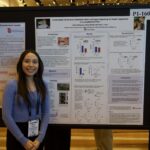
A simulated short-term heat wave alters estrogen signaling to impair oogenesis in a eurythermal fish
I am a second-year M.S. Biology student at California Polytechnic State University, San Luis Obispo, where I work under the mentorship of Dr. Sean C. Lema. My research focuses on the endocrine pathways that drive fish reproduction and how extreme events, such as short-term heatwaves, may impair reproductive success in the Amargosa Pupfish and Sheepshead Minnow. In addition to my research, I am committed to increasing marine science communication to underserved high school students through outreach events organized with the Cal Poly Santa Rosa Creek Foundation.
Lynn Riddiford Award for best poster runner-up: Holland Galante
Elevated testosterone advances daily onset of activity in male house sparrows (Passer domesticus)
Division of Botany
Rising Star in Botany Award for best talk: Andrew Egesa

Environmental impacts and adaptations on Uniola paniculata L, an ecologically important species
I am a postdoc in the Begcy lab at the University of Florida. In the fall of last year, I completed my Ph.D. studies and research on the genetics and molecular physiology of plant adaptations, advised by Dr. Kevin Begcy in the Environmental Horticulture Department. My research interests cover plant development, performance, and environmental interaction.
Rising Star in Botany Award for best poster: Danica Belman
 Size selectivity in aquatic carnivorous plants: expanding predator-prey models to plant predation
Size selectivity in aquatic carnivorous plants: expanding predator-prey models to plant predation
I am a fourth year undergraduate student at California State University, Fresno with broad interests in freshwater ecology. My current research, under Dr. Ulrike Muller, focuses on the feeding of the aquatic carnivorous plant bladderwort, and how plant predation differs from animal predation.
Division of Comparative Physiology and Biochemistry
Best student talk: Emily Lau
 Repeated evolutionary recruitment of dehalogenases in luminous in luminous brittle stars and octocorals
Repeated evolutionary recruitment of dehalogenases in luminous in luminous brittle stars and octocorals
I am interested in understanding how novel traits evolve and the extent to which their evolution is repeatable. My research program, which integrates organismal biology, biochemistry, and molecular evolution, harnesses instances of evolutionary convergence to investigate how processes at the molecular level shape the repeated evolution of novel phenotypes, especially bioluminescence, across levels of biological organization. During SICB 2025, I presented on the repeated evolutionary recruitment of homologous genes for bioluminescence in brittle stars and octocorals. More broadly, this work illustrates how the genomic availability of certain gene families may shape patterns of evolutionary convergence.
Best student poster: Stefane Saruhashi
 How do frozen crickets maintain mitochondrial function?
How do frozen crickets maintain mitochondrial function?
I am a PhD candidate in the Sinclair lab at Cornell University where I study the physiological mechanisms underlying freeze-tolerance in insects. My research combines molecular tools, enzymatic assays, high-resolution respirometry, and spectroscopy to gain an integrative understanding of how freeze-tolerant insects protect themselves from mitochondrial damage, oxidative stress and disruption in ion balance caused by freezing.
Best student poster runner up: Mary Gabrielle

Gene expression changes reveal ground squirrels shift metabolic fuel usage prior to hibernation
I am a senior undergraduate student at Davidson College studying biology and neuroscience. I am primarily interested in neurodegeneration and neuroimmunology, but my interests also extend to the organism level, involving physiology. Through the Colorado State University Molecular Biosciences REU program, I studied how genetic shifts in the liver and white adipose tissues of thirteen-lined ground squirrels may reveal how animals prepare for hibernation in the post-fattening stage.
Division of Evolutionary Developmental Biology
Best student talk: Hana Nagata
 The evolution of insect metamorphosis: A study on the heterochronic role of the gene, chinmo
The evolution of insect metamorphosis: A study on the heterochronic role of the gene, chinmo
Hana is from Tokyo, Japan and she is a biology major and a computer science minor. She is hoping to pursue a research career in the future but would ultimately like to become an educator one day. Aside from working in the lab, she is currently working as a tutor for the CS department and volunteering for Sci-MI (an NPO that provides free research mentorship to hig school students who may be underrepresented in the STEM field) as a curriculum developer. In her free time, Hana likes to listen to music and to draw!
Best student poster: Natalia Padillo-Anthemides
 A putative ctenophore neurogenesis GRN from scRNAseq timecourse
A putative ctenophore neurogenesis GRN from scRNAseq timecourse
Natalia is a third-year PhD candidate in the UF Genetics & Genomics program, studying Evolutionary Developmental Genomics in Dr. Joseph Ryan’s research group at the Whitney Laboratory for Marine Bioscience, St. Augustine, FL. Her research focuses on unraveling the gene regulatory programs that specify cell types, most intriguingly, neurons, in the ctenophore Mnemiopsis, leveraging time-course embryological data from single-cell RNA sequencing.
Division of Ecoimmunology and Disease Ecology
Best student talk: Sila Inanoglu
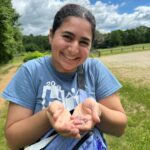
Does incubation temperature influence host defenses in different eastern bluebird populations?
Hosts have evolved and developed defenses, such as tolerance and resistance, against their parasites. Our study looked at not only how these defenses vary across three different populations of eastern bluebirds, but also how they are affected by an experimental temperature treatment during the development of the eggs.
Best student talk runner-up: Lorraine Pérez
Do Darwin’s finch mothers mediate the effects of urbanization on nest parasite pressure?
Best student talk runner-up: Caroline Cummings
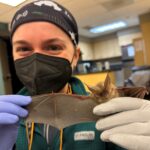 Viral epidemic potential is not uniformly distributed across the bat phylogeny
Viral epidemic potential is not uniformly distributed across the bat phylogeny
I’m a second-year PhD student in Dr. Daniel Becker’s lab at the University of Oklahoma where I collect samples from wild bats, build machine learning models trained on immunological data, and conduct bioanalytical assays to help improve our understanding of how bat immunity mediates zoonotic risk across changing landscapes. My goal is optimize the predictive capacity and performance of statistical models to provide wildlife managers and public health officials with specific and accurate data to inform decision-making for protecting wildlife & human health and conserving biodiversity.
Best student poster: Jenna Palmisano
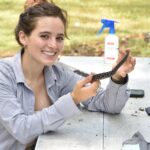 A New Tool for Surveillance: PCR Assay for Raillietiella orientalis Infection in Live Snakes
A New Tool for Surveillance: PCR Assay for Raillietiella orientalis Infection in Live Snakes
The focus of my dissertation is the physiologic and genomic impacts of disease on pygmy rattlesnake populations across Florida. I am focusing on pentastomiasis caused by the invasive, endoparasitic crustacean, Raillietiella orientalis and mycosis caused by two fungal pathogens that impact snakes in the southeastern United States.
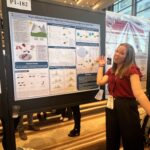 High-altitude adaptation alters the innate immune response in deer mice
High-altitude adaptation alters the innate immune response in deer miceDivision of Ecology and Evolution
Ray Huey Award for best student talk: Isabella Burger
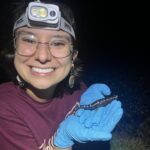 Climate vulnerability is driven by physiological diversity in woodland salamanders
Climate vulnerability is driven by physiological diversity in woodland salamanders
I am a third year PhD student working with Dr. Eric Riddell at the University of North Carolina at Chapel Hill. I study how abiotic and biotic factors influence species’ ranges in woodland salamanders. Specifically, I use species distribution models that incorporate mechanistic and correlative drivers of species’ responses to environmental change to determine how species’ ranges have shifted and may shift through space and time. During this year’s DEE session, I presented results from a new method of calculating climate change vulnerability that incorporates the relationship between exposure, sensitivity, and response when estimating vulnerability.
Ray Huey Award honorable mention: Bridger Creel
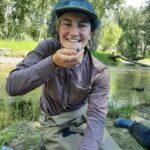
Songbird telomere length reflects metal exposure and habitat degradation from mining contamination
Bridger Creel is a 4th year PhD candidate at the University of Montana studying the effects of mine-waste contamination on riparian songbirds. They work with Drs. Creagh Breuner and Ben Colman in collaboration with the University of Montana Bird Ecology Lab to investigate how songbird diet, physiology and reproductive success change in sites impaired by mining contamination and how metals move through the riparian food web. Their work combines the fields of ecophysiology, food web ecology and ecotoxicology to understand the complex interplay of prey depletion and metal exposure affecting songbirds in mining-impaired habitats. Bridger’s work is fundamentally motivated by a passion for avian conservation.
Ray Huey Award for best student poster: Rachel Bockrath

Shrinking sparrows: How climate change impacts avian morphology and fitness
I am a PhD student at North Dakota State University under Dr. Britt Heidinger. I work with house sparrows (Passer domesticus) investigating how changes in the environment, particularly temperature, impact their morphology and behavior. For this project, I used daily temperature readings and morphological measurements from a population of house sparrows collected over the last 30 years to investigate the link between climate change, body size, and reproductive success. I discovered that mass decreased over time, though not in direct response to developmental temperature. However, tarsus (leg) length increased with higher developmental temperatures, though it was unchanged over time. Preliminary analyses also found that body size was not predictive of reproductive success. This leaves us uncertain about the adaptive interpretation of size changes under climate change, with more analyses planned. Additionally, we are conducting nest temperature manipulation experiments to further investigate the role of temperature in shaping body size and behavior.
Ray Huey Award honorable mention: Emelia Kusi

Plant-pollinator interactions influence pathogenic disease transmission in bumblebees
Emelia Obodum Kusi is a Ph.D. candidate in the Adler Lab at UMass Amherst. Her research explores how various plant species and traits influence pathogen transmission rates and examines the impacts of climate and land use on bumblebee species rarity. Emelia is deeply committed to a collaborative approach in tackling the pressing issue of pollinator decline, recognizing its critical societal implications for global food security.
Division of Invertebrate Zoology
Mary Rice Award for best talk: Julian Katzke

Predation and multifunctionality in the macroevolution of ant mandibles
At the Okinawa Institute of Science and Technology in Japan, I’m a PhD student in the Economo lab studying the evolution of ant mandibles,focusing on the stunning morphological diversification of those primary tools that ant workers use in their plenty of day-to-day activities. Based on a large comparative 3D dataset of mandible shapes, I found that across ants, edges of the morphospace are explored by predatory ants and major workers of polymorphic ants, while intriguingly, ants overall retain a distinct ant-like ground plan whose form-function relationships I would like to explore more in future research.
Mary Rice Award honorable mention: Md Shazid Hasan
 Opsin localization using HCR-FISH in scallop larvae provide new insights into larval photoreception
Opsin localization using HCR-FISH in scallop larvae provide new insights into larval photoreception
Hi, I’m Md Shazid Hasan, a third-year Ph.D. student in the SERB LAB at Iowa State University. My research aims to investigate the diversity and expression patterns of opsins, photoreceptor molecules, in the larvae of pteriomorphian bivalves, exploring their potential roles in detecting environmental cues during development. Specifically, my research tried to identify how many opsins are expressed during different larval stages, where they are expressed, and how they contribute to key processes such as metamorphosis.
Alan Kohn Award for best poster: Katherine Kohn
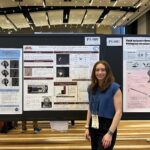
Hydrodynamics of larval urchins: ontogenetic changes and tracer influence
I am a senior at Swarthmore College double majoring in Biology and Mathematics with an emphasis in Statistics. I am interested in addressing biological questions through quantitative methods and am working in Karen Chan’s lab studying the hydrodynamics and feeding behaviors of the larval sea urchin.
Alan Kohn Award honorable mention: Clara DiVincenzo

Symbiotic plasticity in a temperate coral is connected to environment, physiology, and genetics
My name is Clara DiVincenzo and I am an undergraduate junior studying biology and statistics at the University of North Carolina at Chapel Hill. My research in the Castillo Lab investigates the establishment and breakdown of symbioses in temperate corals.
Division of Neurobiology, Neuroethology, and Sensory Biology
Best student talk: Denise Yamhure Ramirez

Dimorphic niches explain sexual dimorphism in the morphology and integration of an orchid bee brain
I am a Colombian biologist and a current fourth year PhD candidate in the Ramirez Lab, at the University of California, Davis. Since my undergraduate degree, I became fascinated by the relationship between the brain and behaviour. I work with insects, given their relatively simple brains that can produce a wide repertoire of fascinating complex behaviours. Currently, my work uses a combination of state-of-the-art imaging techniques, field work and behavioural experiments to study the neuroethology of the orchid bee Euglossa dilemma.
Best student talk honorable mention: Russell Husted Ward
 Opsin-expressing cells in the skin of the summer flounder (Paralichthys dentatus)
Opsin-expressing cells in the skin of the summer flounder (Paralichthys dentatus)
I am a PhD student in Integrative, Comparative, and Marine Biology working under Dr. Lorian Schweikert at the University of North Carolina Wilmington. My research investigates dermal photoreception, or the ability of the skin to detect light, in color-changing fishes. Specifically, I seek to identify photoreceptors (light-detecting cells) within the skin, describe their physiology, and determine the functional significance of this system in the context of color change and other light-informed behaviors.
Best student poster – graduate student: Sara Citron

The evolution of an owl-like auditory system in harriers
I am a PhD student at the University of Lethbridge, Canada, under the supervision of Dr. Andrew Iwaniuk. My research explores the evolution of the brain and sensory systems in birds. This field fascinates me because sensory systems serve as the filter through which animals perceive and interact with their reality, and my goal is to study both extant and extinct species. These systems, along with the brain regions that process the sensory information, are profoundly influenced by a species’ evolutionary history and environment. This complex dynamic leads to both extreme adaptations as well as to overarching patterns, such as the one I presented at SICB 2025. Using a combination of histology, micro-CT scanning, and 3D reconstruction, our study highlighted the convergent evolution between harriers and owls, two groups specialized for hunting through sound.
Best student poster – undergraduate student: Jeremy Daniel Levin

The role of vision and the lateral line system in the jumping behavior of silver hatchetfish
I am a third-year undergraduate studying Biology, Neuroscience and Chemistry at Lake Forest College. My research involves the study of sensory mechanisms underlying ballistic jumping behavior in silver hatchetfish (Gasteropelecus sp.) in Dr. Margot Schwalbe’s lab. Using fluorescent microscopy, I analyze the distribution of the lateral line system, particularly its concentration on the skull and ventral keel. Through high-speed behavioral trials, I investigate how vibrational stimuli trigger jumping responses under varying sensory conditions, including light, darkness, and lateral line ablation. My research aims to uncover the contributions of multiple sensory modalities to fish escape behaviors.
Division of Phylogenetics and Comparative Biology
Wake Award for Best student talk: Jess Sterling
 Mitochondrial resilience: Unveiling the secrets of longevity
Mitochondrial resilience: Unveiling the secrets of longevity
Jess Sterling is a PhD candidate in the Havird Lab at the University of Texas at Austin. Her research focuses on the mitochondrial theory of aging, using comparative phylogenetics to investigate how mitochondrial DNA mutation rates correlate with lifespan across species. By examining substitution rates and mutation spectra in long-lived and short-lived animals, her work aims to shed light on mitochondrial mechanisms that may contribute to extended lifespans.
Wake Award for Best student talk honorable mention: Nathalie Alomar
 Hidden dimensions of diversity in woodland salamanders
Hidden dimensions of diversity in woodland salamanders
My name is Nathalie Alomar, and I am a 4th year PhD candidate in Martha Muñoz’s lab at Yale University. My dissertation work studies the patterns and mechanisms of ecophysiological evolution, with a particular focus on adaptive and non-adaptive radiations. To do this, I investigate physiological and morphological traits in the radiation of woodland salamanders (genus: Plethodon) to better understand their diversification.
Wake Award for Best Student Poster: Dartagnan Mullins
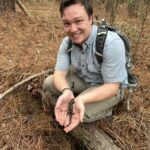
Modularity and rate of phenotypic evolution among Appalachian salamanders (Plethodontidae)
I am a second year PhD student in the Burress lab at UA. My research aims to uncover the mechanisms that have led to the morphological and phenotypic diversity that we see in Appalachian salamanders. I am incredibly grateful to have won the SICB DPCB Wake Award this year, which will help support me as I continue studying this charismatic group of organisms.
Division of Vertebrate Morphology
D. Dwight Davis Award for Best student talk: Karinne Tennenbaum
 Microfossil spiraling teeth reveal paleocene origin of cyclothone (bristlemouths
Microfossil spiraling teeth reveal paleocene origin of cyclothone (bristlemouths
Karinne Tennenbaum is a junior undergraduate at Yale University, majoring in Ecology & Evolutionary Biology with a concentration in Biodiversity and the Environment. Advised by Dr. Elizabeth Sibert, her research focuses on whether characteristic tooth morphology identified in ichthyoliths can resolve the evolutionary origins of deep-sea fish like Cyclothone. She is broadly interested in evolution, physiology, and genetics.
D. Dwight Davis Award for Best student talk honorable mention: Savannah Cobb
 Affiliative behavior and adaptation: the link between primate incisor form and grooming activity
Affiliative behavior and adaptation: the link between primate incisor form and grooming activity
I am a PhD student in Siobhan Cooke’s lab at Johns Hopkins School of Medicine. My current project is reconstructing the dietary ecologies of fossil primates using dental morphological data and Random Forest algorithms in order to better understand the selective pressures underlying evolutionary patterns in the primate lineage. My broad research interest is maximizing the information that may be extracted from fragmentary fossils by incorporating machine learning methodologies and identifying new, robust ecological correlates on understudied skeletal elements.
Karel Liem Award for Best Student Poster: Riley Sombathy
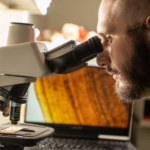
The effects of accelerated growth on the vascular histology of hind limbs in Meleagris gallopavo
I am a 4th year PhD candidate at Ohio University in Patrick O’Connor’s lab and study paleohistology. I am interested in how life history is recorded in bone tissue and on quantifiable methods of studying both histology and growth. My research is currently focused on how body mass and growth rate are recorded in the hind limbs of extinct and extant theropods. My poster focused on the initial results of a novel system we developed using turkeys and quantified growth modeling to determine what influences the development of bone tissue throughout ontogeny.
Karel Liem Award for Best Student Poster: Ada Forester
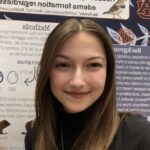 Reduced pore area in zebra finch eggs leads to dark heart coloration regardless of sex
Reduced pore area in zebra finch eggs leads to dark heart coloration regardless of sex
I am an undergraduate student in the Wada Lab at Auburn University, studying genetics. My current research demonstrates how climate change stressors such as increased heat and hypoxic conditions can alter the embryonic development of zebra finches. In the future, I plan to further explore eggshell manipulation and its effects on avian embryos.
Karel Liem Award for Best Student Poster runner-up: Jordan Miller
 Visualizing the anatomy of imperfect tail regeneration in Sphenodon punctatus using DiceµCT
Visualizing the anatomy of imperfect tail regeneration in Sphenodon punctatus using DiceµCT
I am a fourth-year undergraduate at the University of Chicago working in Neil Shubin’s lab. My presentation centered my digital reconstruction of a historical tuatara specimen with a regenerated tail that was stained and scanned using DiceµCT. With this method, we were able to explore the intricacies of this ancient amniote’s regenerated tail, revealing deep similarities between caudal regenerated anatomy in tuatara and other lepidosaurs.

